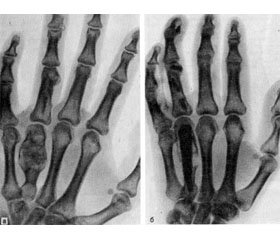Журнал «Боль. Суставы. Позвоночник» 1 (21) 2016
Вернуться к номеру
Diagnostics and treatment issues of the Ollier disease in clinical practice
Авторы: Molotyagin D., Kudryk O. - Kharkiv National Medical University, Kharkiv, Ukraine
Рубрики: Ревматология, Травматология и ортопедия
Разделы: Медицинские форумы
Версия для печати
The article was published on p. 79
Chondrogenic tumors, including chondromas and osteochondromas, are among the majority of the tumors and tumor-like conditions that affect the osseous system. Chondromatosis of the osseous tissue manifests in the evolving malformation of bones which results in falling off of the quality of life (QOL) and to the rise of the rate of patients’ disability.
One of the similar diseases is the Ollier disease. It is a congenital disorder characterized by a unilateral affection of ossa, by shortening and thickening of extremities, change in the manner of walking and lameness. Besides, recurrent irregularly shaped pelvis bones and scoliosis are its frequent characteristics.
Despite the fact that a great amount of research papers with respect to the disease have been published worldwide, many medical practitioners find it difficult to detect the Ollier disease. In Ukraine there are only few occasional descriptions of the disease that report about far from all the typical aspects of the disease.
The multiple scientific literature data and clinical observations report about the complexity in diagnostics of the Ollier disease. It includes a complex diagnostic investigation involving the computer tomography, magnetic resonance imaging, scintigraphy and bone-biopsy together with the conventional methods of research.
Pharmacotherapy approaches in treatment of this symptom complex is being actively discussed, though the final patient management protocol for the Ollier disease has not been developed yet due to some conflicting data.
Therefore, the discussed above field of medical investigation is challenging and showing promise and potential, taking into consideration the low-frequency of the disease in clinical practice, the complexity of diagnostic investigation, absence of a strategy in case management, low effectiveness of conservative therapy. Besides, there is no unique specialists’ opinion as to performing of a surgical correction.

